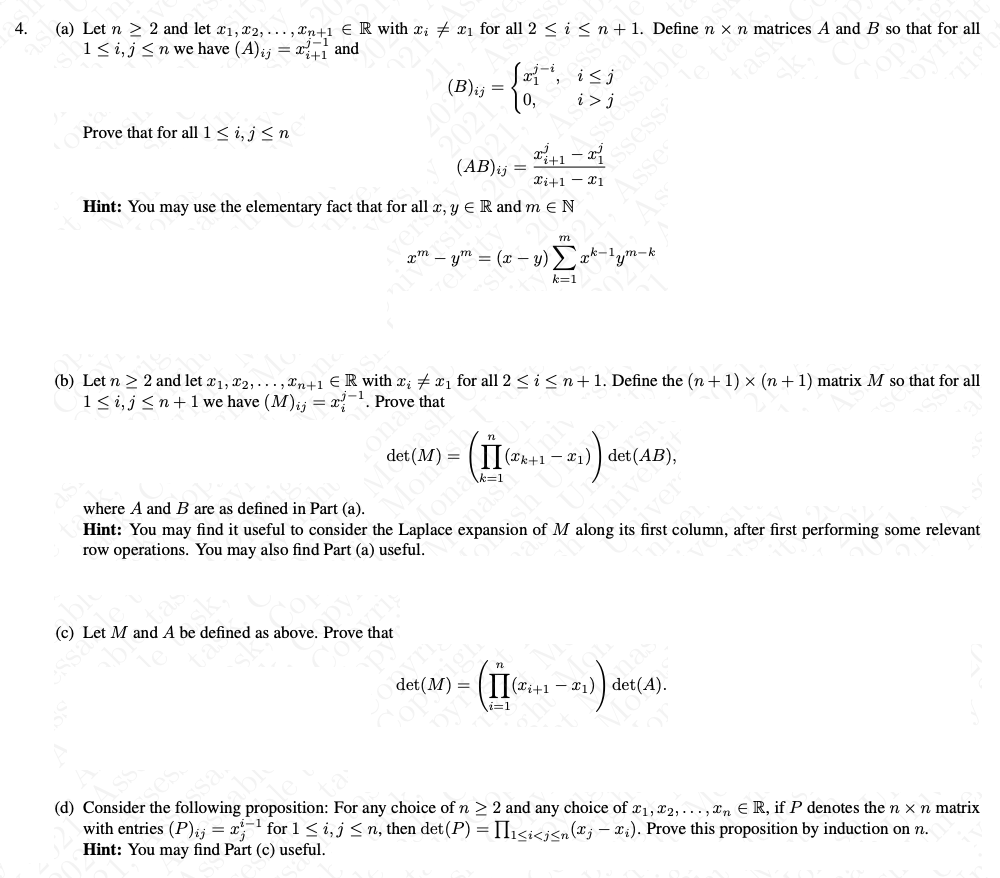Let n > 2 and let æ1, x2, ... , Xn+1 € R with x; x1 for all 2 < i < n + 1. Define n × n matrices A and B so that for all 1j Hint: You may use the elementary fact that for all r, y E R and m E N fask 202 Cops (AB)ij = +1 Li+1 – X1 vers z" – ym = (x – y) ►»*-'ym-k k=1 ssessable ssessa Sse
Let n > 2 and let æ1, x2, ... , Xn+1 € R with x; x1 for all 2 < i < n + 1. Define n × n matrices A and B so that for all 1j Hint: You may use the elementary fact that for all r, y E R and m E N fask 202 Cops (AB)ij = +1 Li+1 – X1 vers z" – ym = (x – y) ►»*-'ym-k k=1 ssessable ssessa Sse
Elementary Linear Algebra (MindTap Course List)
8th Edition
ISBN:9781305658004
Author:Ron Larson
Publisher:Ron Larson
Chapter6: Linear Transformations
Section6.4: Transistion Matrices And Similarity
Problem 15E
Related questions
Question

Transcribed Image Text:(a) Let n > 2 and let ¤1, x2,... , Xn+1 € R with xi + xi for all 2 < i < n + 1. Define n × n matrices A and B so that for all
1<i,j <n we have (A)ij = x and
4.
(B)ij =
Sa, i<j
Prove that for all 1 < i, j < n
(AB)ij
Ti+1 - x1
Hint: You may use the elementary fact that for all x, y E R and m e N
m
xm – ym = (x – y) > a
xk-1,m-k
k=1
(b) Let n > 2 and let x1, x2,... , xn+1 € R with x; x1 for all 2 <i <n+1. Define the (n+ 1) × (n +1) matrix M so that for all
1<i,j <n+ 1 we have (M);i = x?-. Prove that
det (M) =
(II (#k+1 – ¤1) ) det(AB),
where A and B are as defined in Part (a).
k=1
Hint: You may find it useful to consider the Laplace expansion of M along its first column, after first performing some relevant
tona
mas
row operations. You may also find Part (a) useful.
ver
(c) Let M and A be defined as above. Prove that
n
det(M) =
(Ti+1 – x1) ) det(A).
i=1
sa
(d) Consider the following proposition: For any choice of n >2 and any choice of x1, x2, ..., xn E R, if P denotes the n x n matrix
with entries (P);j = x for 1 < i, j < n, then det(P) = II1<i<j<n (x; – x;). Prove this proposition by induction on n.
Hint: You may find Part (c) useful.
ssess
Asse
Expert Solution
This question has been solved!
Explore an expertly crafted, step-by-step solution for a thorough understanding of key concepts.
Step by step
Solved in 3 steps

Recommended textbooks for you

Elementary Linear Algebra (MindTap Course List)
Algebra
ISBN:
9781305658004
Author:
Ron Larson
Publisher:
Cengage Learning

Linear Algebra: A Modern Introduction
Algebra
ISBN:
9781285463247
Author:
David Poole
Publisher:
Cengage Learning

Algebra & Trigonometry with Analytic Geometry
Algebra
ISBN:
9781133382119
Author:
Swokowski
Publisher:
Cengage

Elementary Linear Algebra (MindTap Course List)
Algebra
ISBN:
9781305658004
Author:
Ron Larson
Publisher:
Cengage Learning

Linear Algebra: A Modern Introduction
Algebra
ISBN:
9781285463247
Author:
David Poole
Publisher:
Cengage Learning

Algebra & Trigonometry with Analytic Geometry
Algebra
ISBN:
9781133382119
Author:
Swokowski
Publisher:
Cengage

Elements Of Modern Algebra
Algebra
ISBN:
9781285463230
Author:
Gilbert, Linda, Jimmie
Publisher:
Cengage Learning,